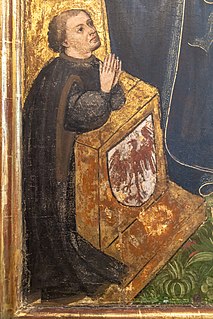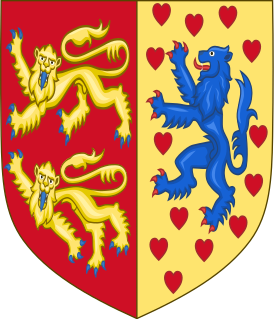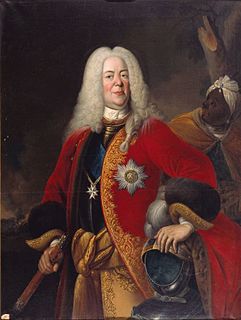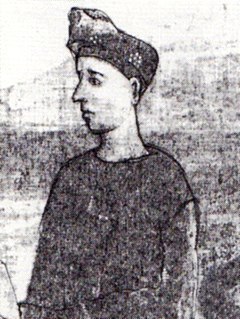
Frederick was the last Burgrave of Nuremberg from 1397 to 1427, Margrave of Brandenburg-Ansbach from 1398, Margrave of Brandenburg-Kulmbach from 1420, and Elector of Brandenburg from 1415 until his death. He became the first member of the House of Hohenzollern to rule the Margraviate of Brandenburg.

The House of Hanover, whose members are known as Hanoverians, is a European royal house of German origin that ruled Hanover, Great Britain, and Ireland at various times during the 17th to 20th centuries. The house originated in 1635 as a cadet branch of the House of Brunswick-Lüneburg, growing in prestige until Hanover became an Electorate in 1692. George I became the first Hanoverian monarch of Great Britain and Ireland in 1714. At Queen Victoria's death in 1901, the throne of the United Kingdom passed to her eldest son Edward VII, a member of the House of Saxe-Coburg and Gotha. The last reigning members of the House lost the Duchy of Brunswick in 1918 when Germany became a republic.
A count palatine, also count of the palace or palsgrave, was originally an official attached to a royal or imperial palace or household and later a nobleman of a rank above that of an ordinary count. The title originated in the late Roman Empire. In the Middle Ages especially and into modern times, it is associated with the Holy Roman Empire.

The House of Welf is a European dynasty that has included many German and British monarchs from the 11th to 20th century and Emperor Ivan VI of Russia in the 18th century.

Leszczyński was a prominent Polish noble family. They were magnates in the Polish–Lithuanian Commonwealth.

Louis Rudolph, a member of the House of Welf, was Duke of Brunswick-Lüneburg and ruling Prince of Wolfenbüttel from 1731 until his death. Since 1707, he ruled as an immediate Prince of Blankenburg.
Magnus, called Magnus with the Necklace or Magnus II, was Duke of Brunswick-Lüneburg, ruling the Brunswick-Lüneburg principalities of Wolfenbüttel and, temporarily, Lüneburg.
The House of Griffin or Griffin dynasty was a dynasty ruling the Duchy of Pomerania from the 12th century until 1637. The name "Griffins" was used by the dynasty after the 15th century and had been taken from the ducal coat of arms. Duke Wartislaw I was the first historical ruler of the Duchy of Pomerania and the founder of the Griffin dynasty. The most prominent Griffin was Eric of Pomerania, who became king of the Kalmar Union in 1397, thus ruling Denmark, Sweden and Norway. The last Griffin duke of Pomerania was Bogislaw XIV, who died during the Thirty Years' War, which led to the division of Pomerania between Brandenburg-Prussia and Sweden. Duchess Anna von Croy, daughter of Duke Bogislaw XIII and the last Griffin, died in 1660.

William II, Duke of Brunswick-Lüneburg was the Prince of Lüneburg from 1330 to 1369.
Frederick II, Frederik II or Friedrich II may refer to:

Elisabeth of Bavaria-Landshut, nicknamed "Beautiful Beth", was an Electress of Brandenburg.

Rudolf I, a member of the House of Ascania, was Duke of Saxe-Wittenberg from 1298 until his death. By the Golden Bull of 1356 he was acknowledged as Elector of Saxony and Marshal of the Holy Roman Empire.